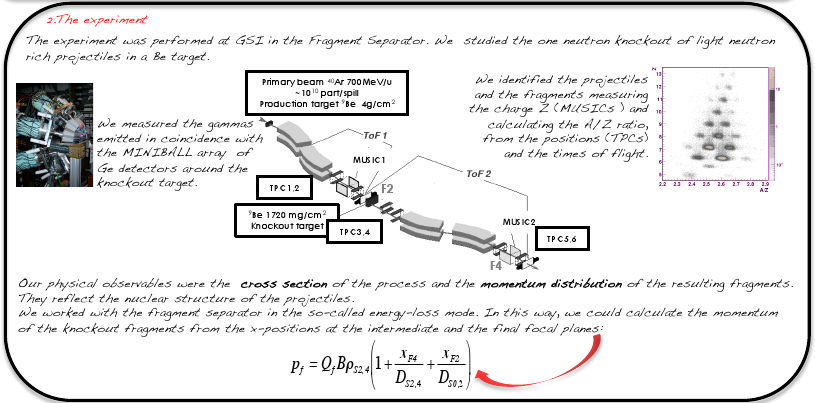DESCRIPTION
Structure of light neutron-rich nuclei using in-beam gamma-ray spectroscopy after breakup reactions

Download poster. (PDF version)
In the last decade, the availability of fast radioactive beams has stimulated the investigation of nuclei far from beta stability. The neutron excess and the low binding energy near the neutron drip line can lead to important changes in the nuclear structure. This is the case for the halo nuclei, that have been extensively studied using the one-neutron knockout technique.
We performed in April 2006 an experiment at the FRS (GSI) applying the one-neutron knockout technique to study neutron rich systems ranging from C to Al. The neutron rich nuclei were obtained by fragmentation of a 40Ar primary beam at 700 A.MeV in a Be target placed at the entrance of the FRS. The first part of the spectrometer was used to identify and transport these nuclei to the intermediate focal place, where the one-neutron knockout reaction took place in a 1720 mg/cm2 Be target. The A-1Z products were selected in the second part of the FRS and guided to the final focal plane. Longitudinal momentum distributions of the A-1Z core-fragments and one-neutron knockout cross sections have been determined. The results clearly reflect the evolution of the nuclear structure with the isospin and the N=14 and N=16 shell effects. Moreover, our data indicate that 22N could be a candidate for a halo nucleus. The setup also included a set of Ge detectors (MINIBALL) surrounding the knockout target. The gamma measurements provided by MINIBALL have been used to disentangle different states of the fragment populated in the one-neutron knockout reactions.
PARTICIPANTS
Participants
C. Rodríguez-Tajes (1), D. Cortina-Gil (1), H. Álvarez-Pol (1), E. Benjamim (1), J. Benlliure (1), M. Caamaño (1), E. Casarejos (1), K. Eppinger (2), H. Geissel (3), R. Gernhäuser (2), B. Jonson(4), R. Krücken (2), T. Kurtukian (1), P. Maierbeck (2), T. Nilsson (4), C. Nociforo (3), D. Pérez (1), A. Prochazka (3), H. Simon (3), K. Sümmerer (3) and H. Weick (3) for the S245 collaboration.
(1) Universidade de Santiago de Compostela, Spain, (2) Technische Universität München, Germany, (3) Gesellschaft für Schwerionenforschung, Germany, (4) Chalmers Tekniska Högskola, Sweden


